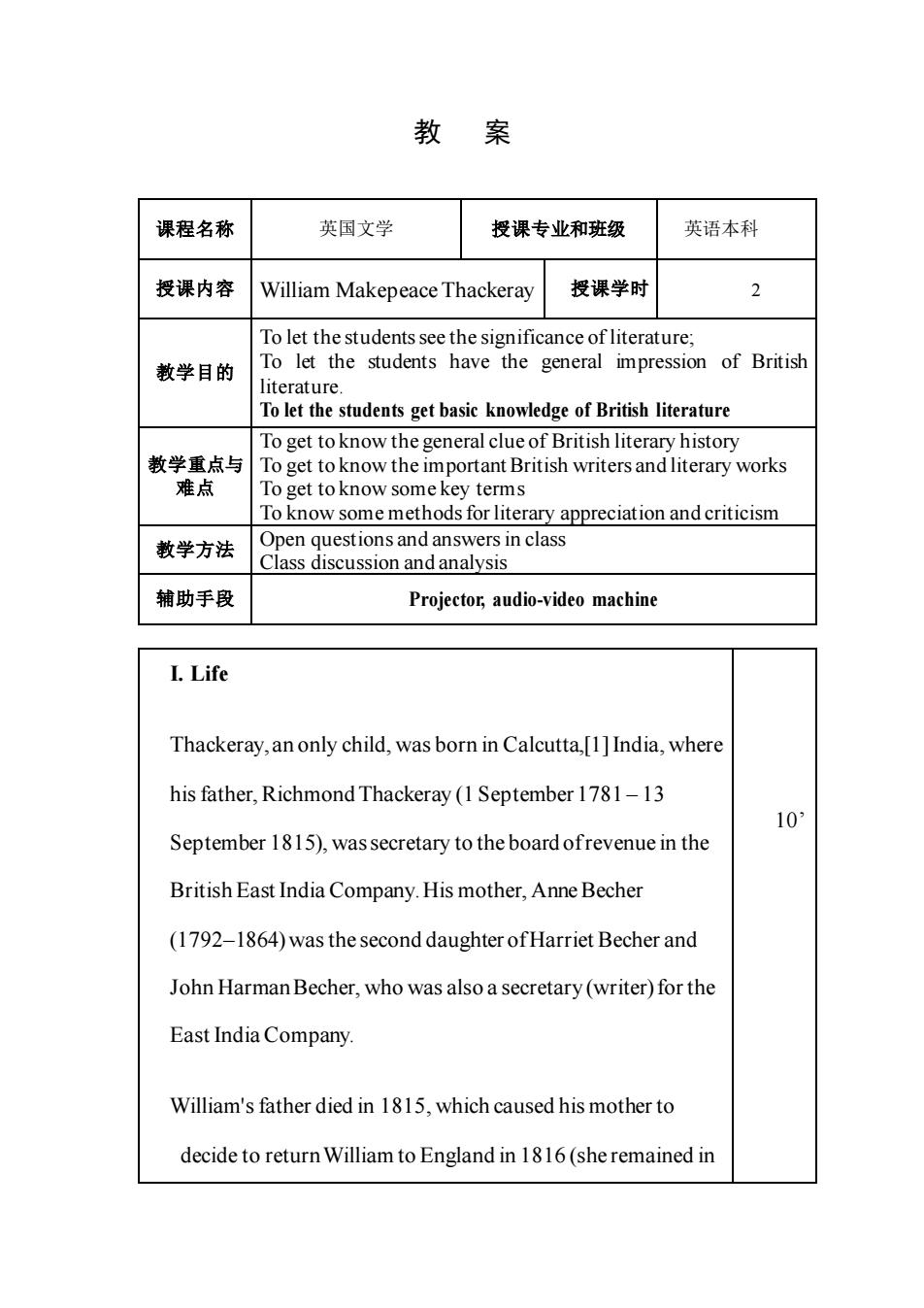
教案 课程名称 英国文学 授课专业和班级 英语本科 授课内容 William Makepeace Thackeray 授课学时 To let the students see the significance of literature 教学目的 To let the students have the general impression of British literature. To let the students get basic knowledge of British literature To get to know the general clue of British literary history 教学重点与To get to know the important British writers and literary works 难点 To get to know some key terms To know some methods for literary appreciation and criticism 教学方法 辅助手段 Projector,audio-video machine I.Life Thackeray,an only child,was born in Calcutta,[1]India,where his father,Richmond Thackeray(1 September 1781-13 10 September 1815),was secretary to the board ofrevenue in the British East India Company.His mother,Anne Becher (1792-1864)was the second daughter ofHarriet Becher and John Harman Becher,who was also a secretary(writer)for the East India Company. William's father died in 1815,which caused his mother to decide to return William to England in 1816(she remained in
教 案 课程名称 英国文学 授课专业和班级 英语本科 授课内容 William Makepeace Thackeray 授课学时 2 教学目的 To let the students see the significance of literature; To let the students have the general impression of British literature. To let the students get basic knowledge of British literature 教学重点与 难点 To get to know the general clue of British literary history To get to know the important British writers and literary works To get to know some key terms To know some methods for literary appreciation and criticism 教学方法 Open questions and answers in class Class discussion and analysis 辅助手段 Projector, audio-video machine I. Life Thackeray, an only child, was born in Calcutta,[1]India, where his father, Richmond Thackeray (1 September 1781 – 13 September 1815), was secretary to the board of revenue in the British East India Company. His mother, Anne Becher (1792–1864) was the second daughter of Harriet Becher and John Harman Becher, who was also a secretary (writer) for the East India Company. William's father died in 1815, which caused his mother to decide to return William to England in 1816 (she remained in 10’
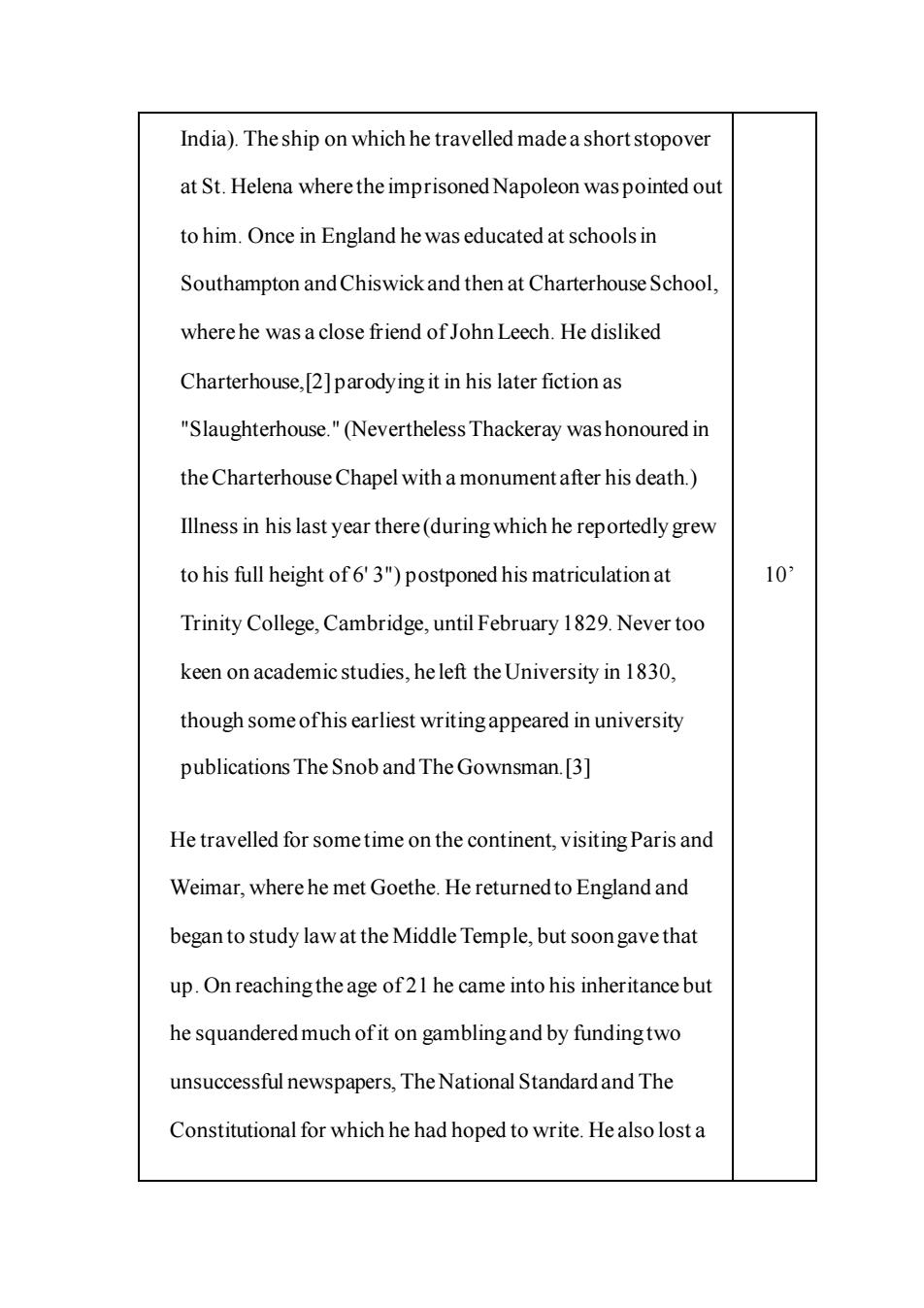
India).Theship on which he travelled made a short stopover at St.Helena where the imprisoned Napoleon was pointed out to him.Once in England he was educated at schools in Southampton and Chiswick and then at Charterhouse School where he was a close friend of John Leech.He disliked Charterhouse,[2]parodying it in his later fiction as "Slaughterhouse."(Nevertheless Thackeray was honoured in the Charterhouse Chapel with a monument after his death.) Illness in his last year there(during which he reportedly grew to his full height of63")postponed his matriculation at 10 Trinity College,Cambridge,until February 1829.Never too keen onacademicstudies,heleft the University in 1830. though some ofhis earliest writingappeared in university publications The Snob and The Gownsman.[3] He travelled for some time on the continent,visiting Paris and Weimar,where he met Goethe.He returned to England and began to study law at the Middle Temple,but soongave that up.On reachingthe age of21 he came into his inheritance but he squandered much of it on gamblingand by fundingtwo unsuccessful newspapers,The National Standard and The Constitutional for which he had hoped to write.He also lost a
India). The ship on which he travelled made a short stopover at St. Helena where the imprisoned Napoleon was pointed out to him. Once in England he was educated at schools in Southampton and Chiswick and then at Charterhouse School, where he was a close friend of John Leech. He disliked Charterhouse,[2] parodying it in his later fiction as "Slaughterhouse." (Nevertheless Thackeray was honoured in the Charterhouse Chapel with a monument after his death.) Illness in his last year there (during which he reportedly grew to his full height of 6' 3") postponed his matriculation at Trinity College, Cambridge, until February 1829. Never too keen on academic studies, he left the University in 1830, though some of his earliest writing appeared in university publications The Snob and The Gownsman.[3] He travelled for some time on the continent, visiting Paris and Weimar, where he met Goethe. He returned to England and began to study law at the Middle Temple, but soon gave that up. On reaching the age of 21 he came into his inheritance but he squandered much of it on gambling and by funding two unsuccessful newspapers, The National Standard and The Constitutional for which he had hoped to write. He also lost a 10’
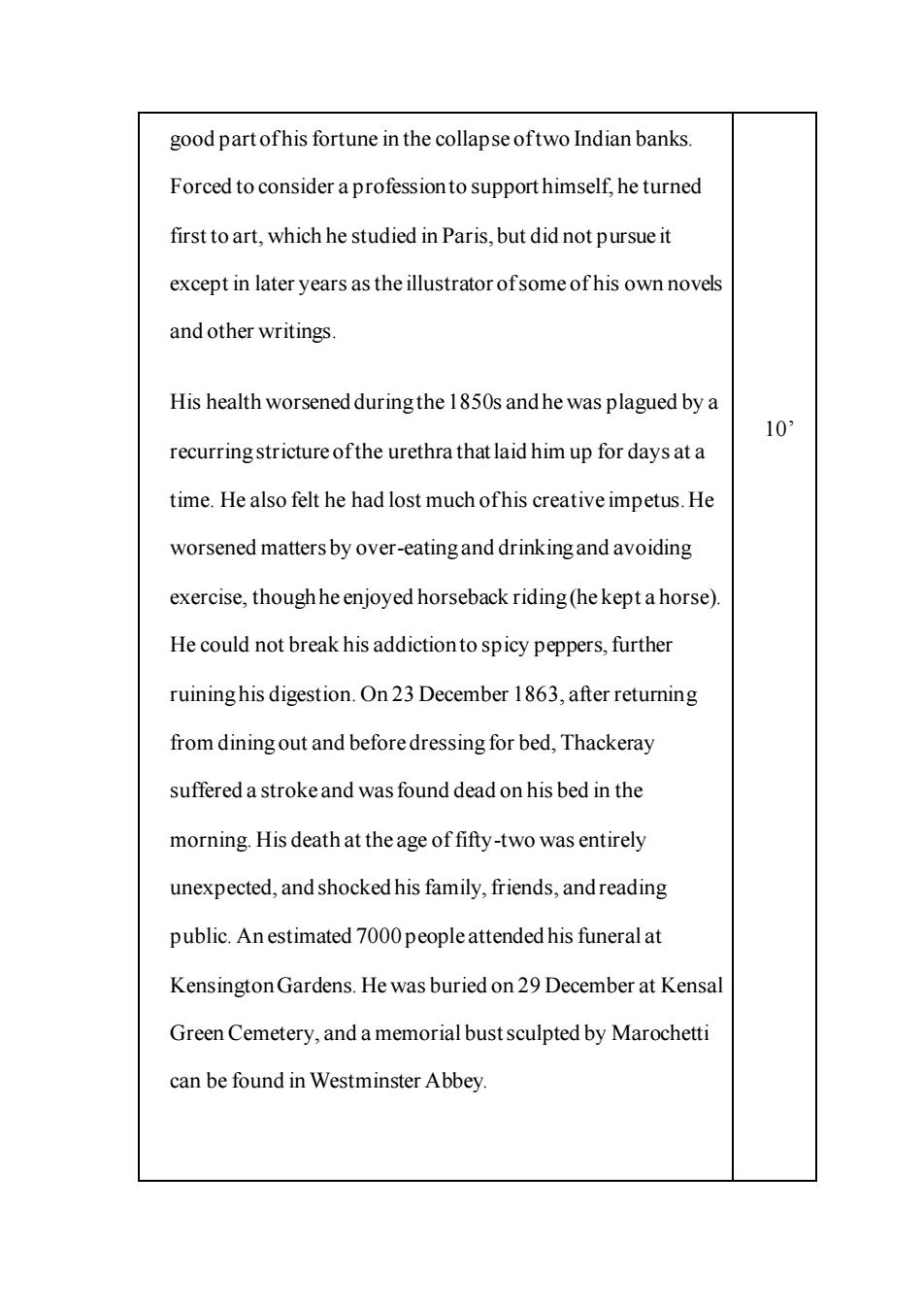
good part ofhis fortune in the collapse oftwo Indian banks Forced to consider a profession to support himself,he turned first to art,which he studied in Paris,but did not pursue it except in later years as the illustrator ofsome ofhis own novels and other writings. His health worsened duringthe 1850s and he was plagued by a 10 recurring stricture ofthe urethra that laid him up for days at a time.He also felt he had lost much ofhis creative impetus.He worsened matters by over-eatingand drinking and avoiding exercise,though he enjoyed horseback riding(he kept a horse). He could not break his addictionto spicy peppers,further ruininghis digestion.On23 December 1863,after returning from dining out and before dressing for bed,Thackeray suffered a strokeand was found dead on his bed in the morning.His death at the age of fifty-two was entirely unexpected,and shocked his family,friends,and reading public.An estimated 7000people attended his funeral at Kensington Gardens.He was buried on 29 December at Kensal Green Cemetery,and a memorial bust sculpted by Marochetti can be found in Westminster Abbey
good part of his fortune in the collapse of two Indian banks. Forced to consider a profession to support himself, he turned first to art, which he studied in Paris, but did not pursue it except in later years as the illustrator of some of his own novels and other writings. His health worsened during the 1850s and he was plagued by a recurring stricture of the urethra that laid him up for days at a time. He also felt he had lost much of his creative impetus. He worsened matters by over-eating and drinking and avoiding exercise, though he enjoyed horseback riding (he kept a horse). He could not break his addiction to spicy peppers, further ruining his digestion. On 23 December 1863, after returning from dining out and before dressing for bed, Thackeray suffered a stroke and was found dead on his bed in the morning. His death at the age of fifty-two was entirely unexpected, and shocked his family, friends, and reading public. An estimated 7000 people attended his funeral at Kensington Gardens. He was buried on 29 December at Kensal Green Cemetery, and a memorial bust sculpted by Marochetti can be found in Westminster Abbey. 10’
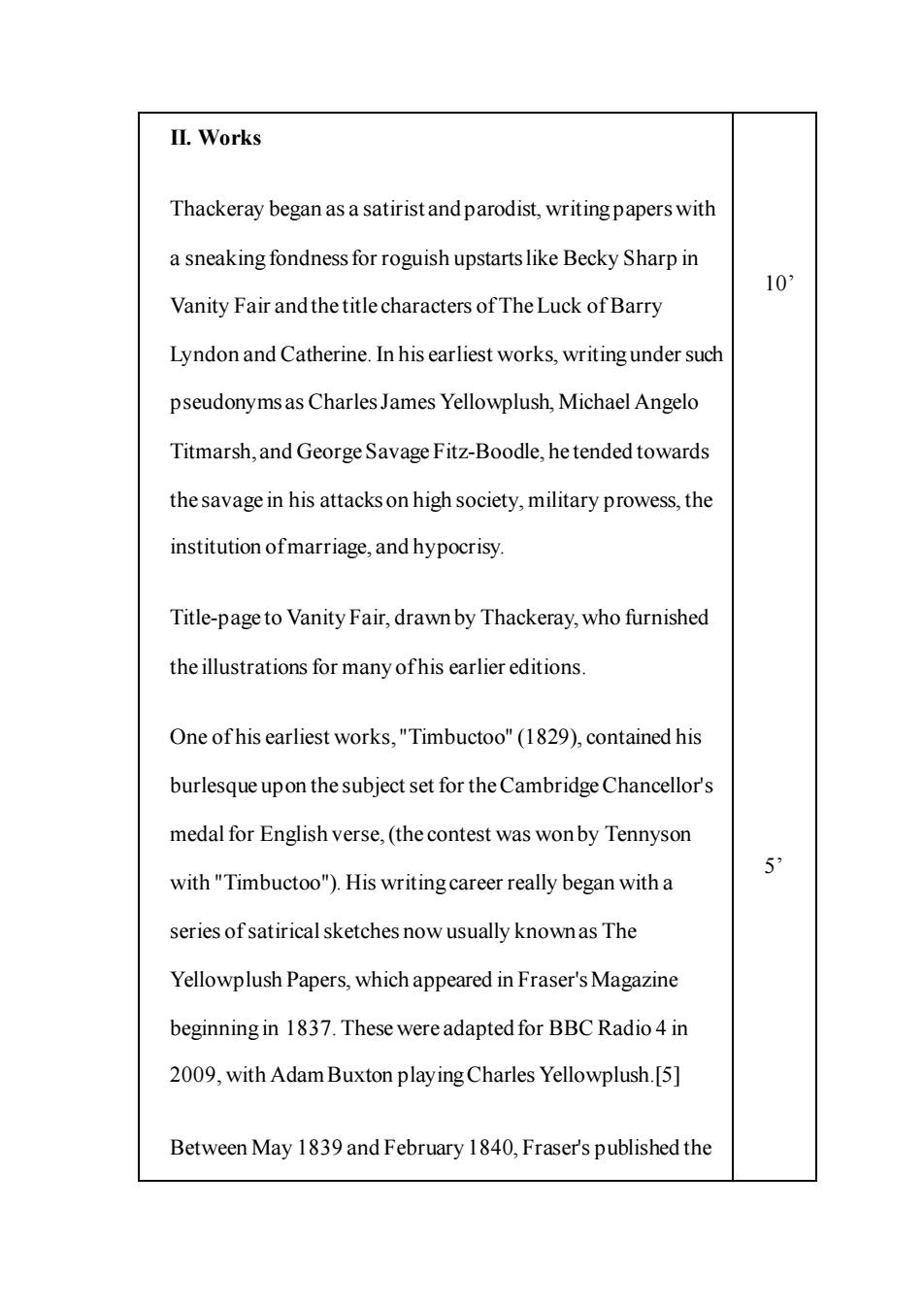
II.Works Thackeray began as a satirist and parodist,writing papers with a sneaking fondness for roguish upstarts like Becky Sharp in 10: Vanity Fair and thetitlecharacters of The Luck of Barry Lyndon and Catherine.In his earliest works,writing under such pseudonymsas Charles James Yellowplush,Michael Angelo Titmarsh,and George Savage Fitz-Boodle,he tended towards the savage in his attacks on high society,military prowess,the institution ofmarriage,and hypocrisy. Title-page to Vanity Fair,drawn by Thackeray,who furnished the illustrations for many ofhis earlier editions. One ofhis earliest works,"Timbuctoo"(1829),contained his burlesque upon the subject set for the Cambridge Chancellor's medal for English verse,(the contest was wonby Tennyson 5 with"Timbuctoo").His writingcareer really began with a series of satirical sketches now usually knownas The Yellowplush Papers,whichappeared in Fraser's Magazine beginning in 1837.These were adapted for BBC Radio 4 in 2009,with Adam Buxton playing Charles Yellowplush.[5] Between May 1839 and February 1840,Fraser's published the
II. Works Thackeray began as a satirist and parodist, writing papers with a sneaking fondness for roguish upstarts like Becky Sharp in Vanity Fair and the title characters of The Luck of Barry Lyndon and Catherine. In his earliest works, writing under such pseudonyms as Charles James Yellowplush, Michael Angelo Titmarsh, and George Savage Fitz-Boodle, he tended towards the savage in his attacks on high society, military prowess, the institution of marriage, and hypocrisy. Title-page to Vanity Fair, drawn by Thackeray, who furnished the illustrations for many of his earlier editions. One of his earliest works, "Timbuctoo" (1829), contained his burlesque upon the subject set for the Cambridge Chancellor's medal for English verse, (the contest was won by Tennyson with "Timbuctoo"). His writing career really began with a series of satirical sketches now usually known as The Yellowplush Papers, which appeared in Fraser's Magazine beginning in 1837. These were adapted for BBC Radio 4 in 2009, with Adam Buxton playing Charles Yellowplush.[5] Between May 1839 and February 1840, Fraser's published the 10’ 5’
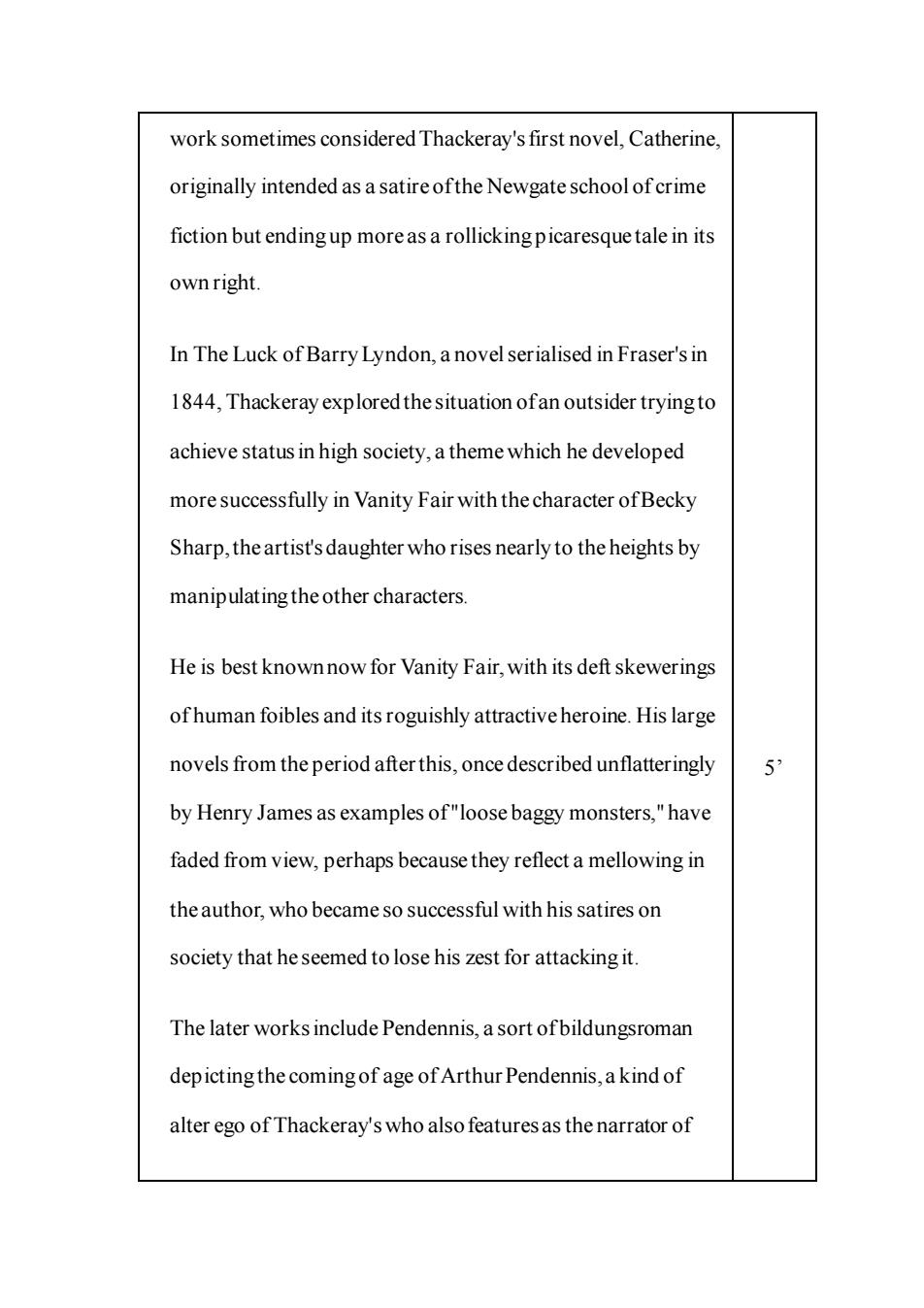
work sometimes considered Thackeray's first novel,Catherine originally intended as a satire ofthe Newgate school of crime fiction but endingup moreas a rollickingpicaresque tale in its own right In The Luck of Barry Lyndon,a novel serialised in Fraser's in 1844,Thackeray explored thesituation ofan outsider tryingto achieve status in high society,a theme which he developed more successfully in Vanity Fair with the character of Becky Sharp,the artist's daughter who rises nearly to the heights by manipulating the other characters. He is best knownnow for Vanity Fair,with its deft skewerings ofhuman foibles and its roguishly attractiveheroine.His large novels from the period after this,once described unflatteringly by Henry James as examples of"loose baggy monsters,"have faded from view,perhaps because they reflect a mellowing in the author,who became so successful with his satires on society that heseemed to lose his zest for attacking it. The later works include Pendennis,a sort ofbildungsroman depictingthe coming of age of Arthur Pendennis,a kind of alter ego of Thackeray's who also featuresas the narrator of
work sometimes considered Thackeray's first novel, Catherine, originally intended as a satire of the Newgate school of crime fiction but ending up more as a rollicking picaresque tale in its own right. In The Luck of Barry Lyndon, a novel serialised in Fraser's in 1844, Thackeray explored the situation of an outsider trying to achieve status in high society, a theme which he developed more successfully in Vanity Fair with the character of Becky Sharp, the artist's daughter who rises nearly to the heights by manipulating the other characters. He is best known now for Vanity Fair, with its deft skewerings of human foibles and its roguishly attractive heroine. His large novels from the period after this, once described unflatteringly by Henry James as examples of "loose baggy monsters," have faded from view, perhaps because they reflect a mellowing in the author, who became so successful with his satires on society that he seemed to lose his zest for attacking it. The later works include Pendennis, a sort of bildungsroman depicting the coming of age of Arthur Pendennis, a kind of alter ego of Thackeray's who also features as the narrator of 5’

two later novels,The Newcomes and The Adventures of Philip The Newcomes is noteworthy for its critical portrayal ofthe "marriage market,"while Philip is noteworthy for its semi-autobiographical depictionof Thackeray'searly life,in which the author partially regains some ofhis early satirical zest. Also notable among the later novels is The History ofHenry Esmond,in which Thackeray triedto write a novel in the style ofthe eighteenth century.In fact,the eighteenth century held a great appeal for Thackeray.Notonly Esmond but also Barry Lyndon and Catherineare set then,as is the sequel to Esmond The Virginians,which takes place in America and includes George Washington as a character who nearly kills one of the protagonists in a duel. III.Reputation and legacy During the Victorianera,Thackeray was ranked second only to 10 Charles Dickens,buthe is now much less read and is known almost exclusively for Vanity Fair.In that novel he was able to satirise whole swaths ofhumanity while retaining a light touch. It also features his most memorable character,the engagingly
two later novels, The Newcomes and The Adventures of Philip. The Newcomes is noteworthy for its critical portrayal of the "marriage market," while Philip is noteworthy for its semi-autobiographical depiction of Thackeray's early life, in which the author partially regains some of his early satirical zest. Also notable among the later novels is The History of Henry Esmond, in which Thackeray tried to write a novel in the style of the eighteenth century. In fact, the eighteenth century held a great appeal for Thackeray. Not only Esmond but also Barry Lyndon and Catherine are set then, as is the sequel to Esmond, The Virginians, which takes place in America and includes George Washington as a character who nearly kills one of the protagonists in a duel. III. Reputation and legacy During the Victorian era, Thackeray was ranked second only to Charles Dickens, but he is now much less read and is known almost exclusively for Vanity Fair. In that novel he was able to satirise whole swaths of humanity while retaining a light touch. It also features his most memorable character, the engagingly 10’

roguish Becky Sharp.As a result,unlike Thackeray's other novels,it remains popular with the general reading public;it is a standard fixture in university courses and has been repeatedly adapted for movies and television In Thackeray's own day,some commentators,such as Anthony Trollope,ranked his History of Henry Esmondas his greatest work,perhaps because it expressed Victorian values ofduty and earnestness,as did some ofhis other later novels.It is perhaps for this reason that they have not survived as well as Vanity Fair,which satirises those values. Thackeray saw himselfas writing in the realistic traditionand distinguished himself from theexaggerationsand sentimentality ofDickens.Some later commentators have accepted this self-evaluation and seen him as a realist,but others note his inclinationto useeighteenth-century narrative techniques,suchas digressions and talkingto the reader,and argue that through them he frequently disrupts the illusion of reality.The school of Henry James,with its emphasis on maintaining that illusion,marked a break with Thackeray's techniques
roguish Becky Sharp. As a result, unlike Thackeray's other novels, it remains popular with the general reading public; it is a standard fixture in university courses and has been repeatedly adapted for movies and television. In Thackeray's own day, some commentators, such as Anthony Trollope, ranked his History of Henry Esmond as his greatest work, perhaps because it expressed Victorian values of duty and earnestness, as did some of his other later novels. It is perhaps for this reason that they have not survived as well as Vanity Fair, which satirises those values. Thackeray saw himself as writing in the realistic tradition and distinguished himself from the exaggerations and sentimentality of Dickens. Some later commentators have accepted this self-evaluation and seen him as a realist, but others note his inclination to use eighteenth-century narrative techniques, such as digressions and talking to the reader, and argue that through them he frequently disrupts the illusion of reality. The school of Henry James, with its emphasis on maintaining that illusion, marked a break with Thackeray's techniques
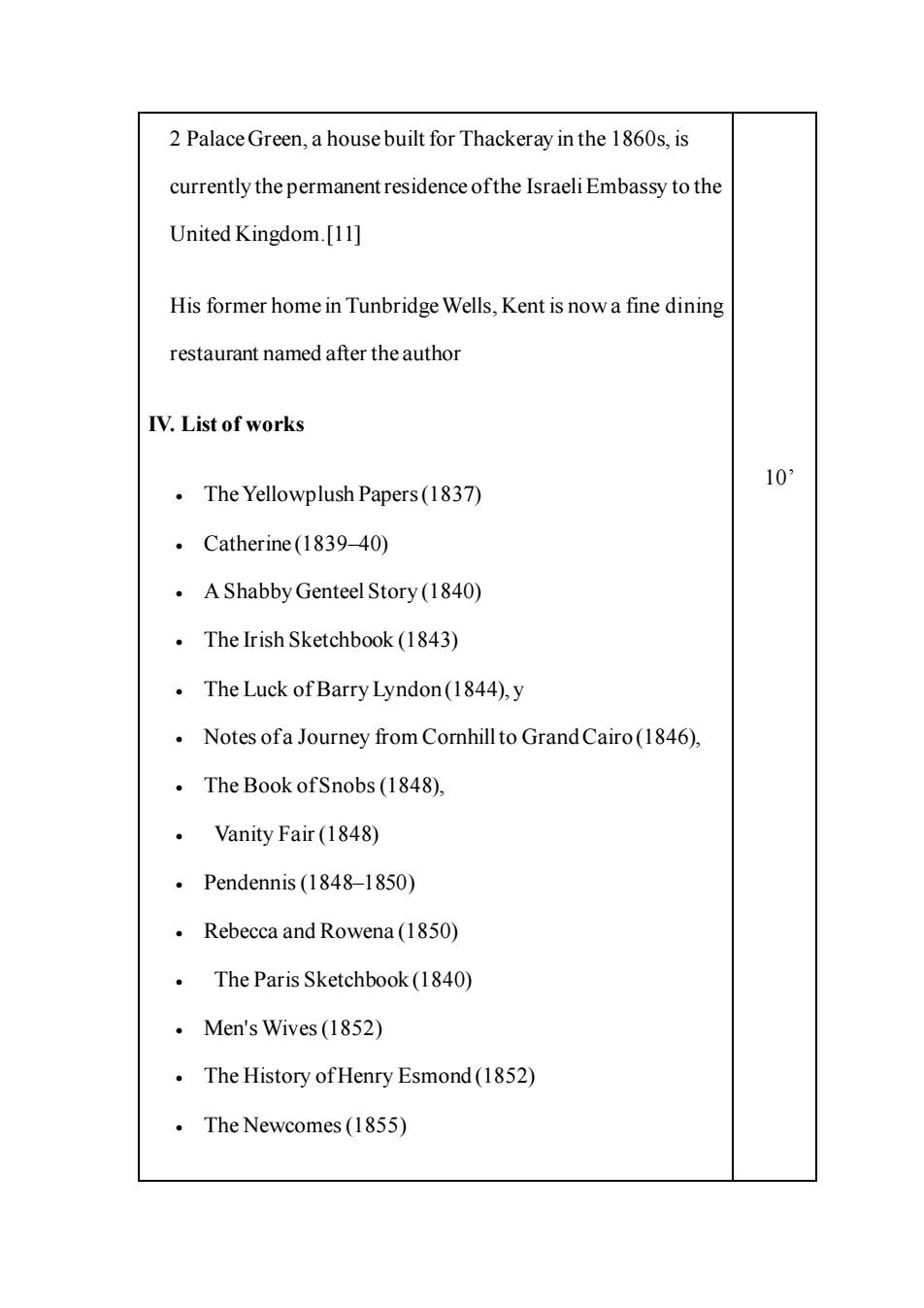
2 Palace Green,a house built for Thackeray in the 1860s,is currently the permanent residence ofthe Israeli Embassy to the United Kingdom.[11] His former home in Tunbridge Wells,Kent is now a fine dining restaurant named after the author IV.List of works The Yellowplush Papers(1837) 10 ·Catherine(1839-40) A Shabby Genteel Story(1840) The Irish Sketchbook(1843) The Luck of Barry Lyndon(1844).y Notes ofa Journey from Comnhill to Grand Cairo(1846). The Book ofSnobs(1848). Vanity Fair(1848) Pendennis(1848-1850) Rebecca and Rowena(1850) The Paris Sketchbook(1840) Men's Wives(1852) The History ofHenry Esmond(1852) The Newcomes(1855)
2 Palace Green, a house built for Thackeray in the 1860s, is currently the permanent residence of the Israeli Embassy to the United Kingdom.[11] His former home in Tunbridge Wells, Kent is now a fine dining restaurant named after the author IV. List of works • The Yellowplush Papers(1837) • Catherine (1839–40) • A Shabby Genteel Story (1840) • The Irish Sketchbook (1843) • The Luck of Barry Lyndon (1844), y • Notes of a Journey from Cornhill to Grand Cairo (1846), • The Book of Snobs (1848), • Vanity Fair (1848) • Pendennis (1848–1850) • Rebecca and Rowena (1850) • The Paris Sketchbook (1840) • Men's Wives(1852) • The History of Henry Esmond (1852) • The Newcomes (1855) 10’
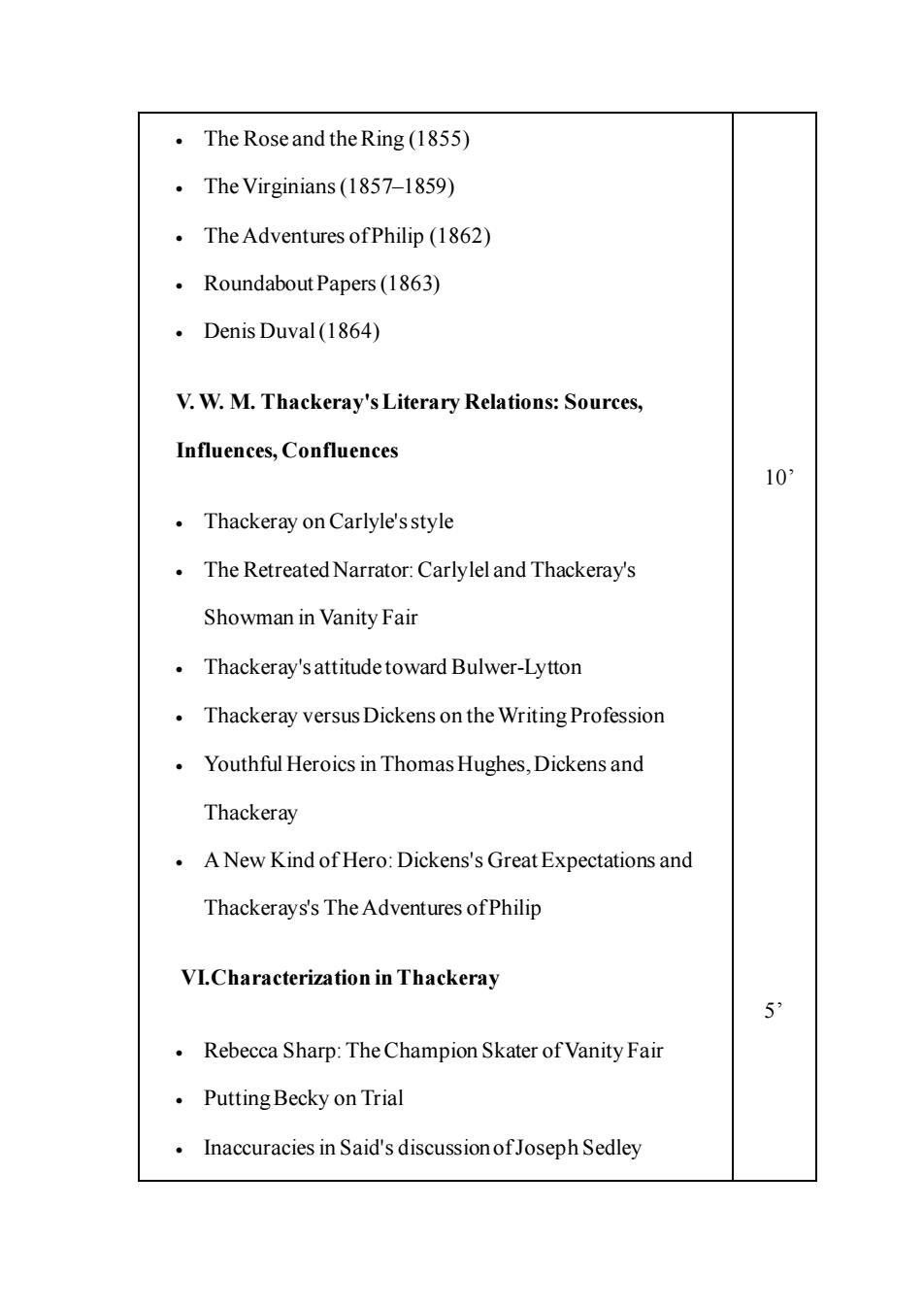
The Rose and the Ring(1855) The Virginians(1857-1859) The Adventures ofPhilip(1862) Roundabout Papers(1863) Denis Duval(1864) V.W.M.Thackeray's Literary Relations:Sources, Influences,Confluences 10 Thackeray on Carlyle'sstyle The Retreated Narrator:Carlylel and Thackeray's Showman in Vanity Fair Thackeray's attitude toward Bulwer-Lytton Thackeray versus Dickens on the Writing Profession Youthful Heroics in Thomas Hughes,Dickens and Thackeray A New Kind of Hero:Dickens's Great Expectations and Thackerays's The Adventures ofPhilip VI.Characterization in Thackeray 5 Rebecca Sharp:The Champion Skater of Vanity Fair Putting Becky on Trial Inaccuracies in Said's discussionof Joseph Sedley
• The Rose and the Ring (1855) • The Virginians (1857–1859) • The Adventures of Philip (1862) • Roundabout Papers (1863) • Denis Duval(1864) V. W. M. Thackeray's Literary Relations: Sources, Influences, Confluences • Thackeray on Carlyle's style • The Retreated Narrator: Carlylel and Thackeray's Showman in Vanity Fair • Thackeray's attitude toward Bulwer-Lytton • Thackeray versus Dickens on the Writing Profession • Youthful Heroics in Thomas Hughes, Dickens and Thackeray • A New Kind of Hero: Dickens's Great Expectations and Thackerays's The Adventures of Philip VI.Characterization in Thackeray • Rebecca Sharp: The Champion Skater of Vanity Fair • Putting Becky on Trial • Inaccuracies in Said's discussion of Joseph Sedley 10’ 5’
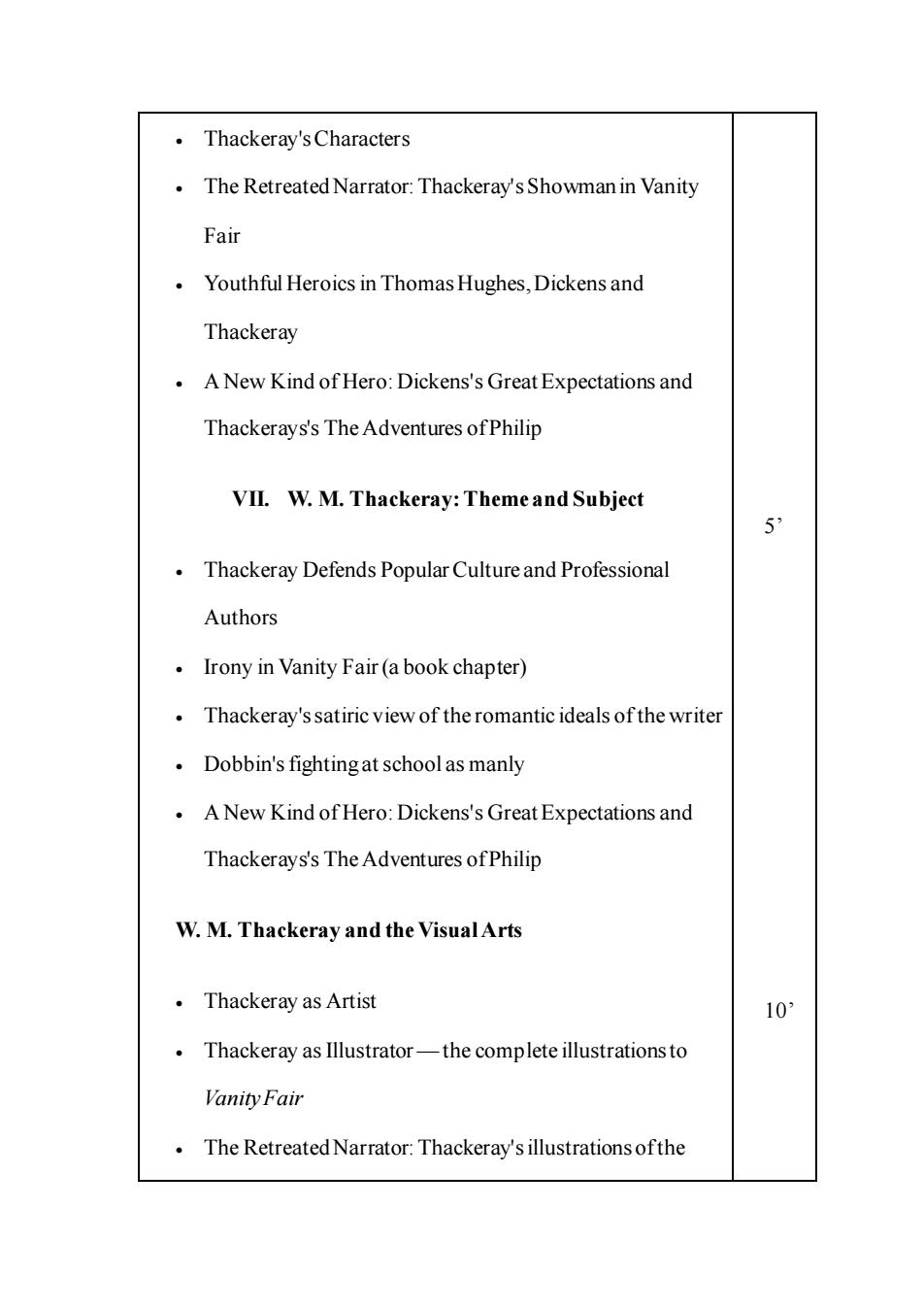
Thackeray's Characters The Retreated Narrator:Thackeray's Showman in Vanity Fair Youthful Heroics in Thomas Hughes,Dickens and Thackeray A New Kind of Hero:Dickens's Great Expectations and Thackerays's The Adventures ofPhilip VII.W.M.Thackeray:Theme and Subject 5 Thackeray Defends Popular Culture and Professional Authors Irony in Vanity Fair(a book chapter) Thackeray's satiric view of the romantic ideals of the writer Dobbin's fightingat schoolas manly A New Kind of Hero:Dickens's Great Expectations and Thackerays's The Adventures ofPhilip W.M.Thackeray and the VisualArts ·Thackeray as Artist 10 Thackeray as Illustrator-the complete illustrationsto Vanity Fair The Retreated Narrator:Thackeray's illustrations ofthe
• Thackeray's Characters • The Retreated Narrator: Thackeray's Showman in Vanity Fair • Youthful Heroics in Thomas Hughes, Dickens and Thackeray • A New Kind of Hero: Dickens's Great Expectations and Thackerays's The Adventures of Philip VII. W. M. Thackeray: Theme and Subject • Thackeray Defends Popular Culture and Professional Authors • Irony in Vanity Fair(a book chapter) • Thackeray's satiric view of the romantic ideals of the writer • Dobbin's fighting at school as manly • A New Kind of Hero: Dickens's Great Expectations and Thackerays's The Adventures of Philip W. M. Thackeray and the Visual Arts • Thackeray as Artist • Thackeray as Illustrator —the complete illustrations to Vanity Fair • The Retreated Narrator: Thackeray's illustrations of the 5’ 10’